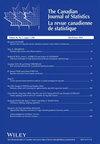Introduction to the special issue on the 50th anniversary of CJS
IF 1
4区 数学
Q3 STATISTICS & PROBABILITY
Canadian Journal of Statistics-Revue Canadienne De Statistique
Pub Date : 2022-11-30
DOI:10.1002/cjs.11757
引用次数: 0
Abstract
With great pleasure, we present these introductory editorial lines to celebrate the 50th anniversary of The Canadian Journal of Statistics (CJS) and the statistical community of Canada. The 50th anniversary committee for the celebrations, with the support of former editor-in-chief Fang Yao, decided to run a special issue to mark the occasion. We were fortunate to receive 15 interesting manuscripts covering a broad variety of research topics and reflecting the diversity and excellence of the research conducted by Canadian statisticians. Before describing those contributions, we would like to thank the former and current editors-in-chief of CJS, Fang Yao and Johanna G. Nešlehová, for their work setting up this special issue, with help from their assistant Julie Falkner. We are also grateful to the managing editor, Bouchra Nasri, who assisted us from the beginning and arranged with Wiley a year of free-to-read access to the articles of this issue. The opening article is contributed by Nancy Reid in honour of the late Don A.S. Fraser. She elegantly describes how Don’s work has influenced asymptotic theory in the statistical sciences. The article recalls Don’s great memories and good humour around the philosophical trends of estimation theory. Two mathematical statistics articles follow. The first of these, by Csörgő, Dawson, Nasri, and Rémillard, reviews the contributions of some Canadian statisticians to empirical processes, including copula processes, with applications to goodness-of-fit tests, change-point tests, and tests of independence, among others. The second, by Mathai and Provost, explores the densities of singular matrices constructed from the product of Gaussian matrices, extending the Wishart distribution. Our focus then moves to sampling theory. The article by Chen, Li, Rao, and Wu discusses inference for nonprobability survey samples using pseudo empirical likelihood methods; it explores the contributions of Canadian researchers to these topics. Beaumont and Haziza then present a critical review of three estimation approaches for finite population samples: Bayesian, parametric, and nonparametric. The next topic is computational statistics and complex data analysis. First, Andrews and Field reflect on the challenges of analyzing increasingly complex data with robust methods. Craiu, Gustafson, and Rosenthal then give an overview of recent advances in Bayesian inference and Markov chain Monte Carlo methods, highlighting the challenges posed by big data and intractable likelihoods. The third article, by Chipman and Bingham, proposes the use of the design and analysis of experiments to improve simulation studies. Finally, Xun, Guan, and Cao deal with functional data estimation, assuming a short-term dependence and using finite element methods. The section on topics in biostatistics begins with an interesting review by Cook and Lawless that highlights issues of life history analysis with multistate models, including recent advances and future challenges. Moodie and Stephens provide an overview of causal inference, historical developments, and current research directions. Zhang and Sun then explore the use of regression methods for a unified approach to genetic association tests, showing that developing robust methods for association is still a domain of interest. Finally, Susko presents complex models used for phylogenetic inference as well as future research directions in this field. Our final articles discuss collaborative work. Dean, El-Shaarawi, Esterby, Mills Flemming, Routledge, Taylor, Woolford, Zidek, and Zwiers review the important and successful Canadian香港邮政成立五十周年特刊简介
我们非常高兴地发表这些介绍性社论,以庆祝《加拿大统计杂志》和加拿大统计界成立50周年。庆祝活动50周年委员会在前总编辑方遥的支持下,决定发行一期特刊来纪念这一时刻。我们很幸运地收到了15份有趣的手稿,涵盖了广泛的研究主题,反映了加拿大统计学家进行的研究的多样性和卓越性。在介绍这些贡献之前,我们要感谢《CJS》前任和现任主编方遥和Johanna G.Nešlehová在其助理Julie Falkner的帮助下为本期特刊所做的工作。我们也感谢总编辑Bouchra Nasri,他从一开始就为我们提供帮助,并安排Wiley免费阅读本期文章一年。开篇文章由南希·里德撰写,以纪念已故的唐·A·S·弗雷泽。她优雅地描述了唐的工作如何影响统计科学中的渐近理论。这篇文章回顾了唐关于估计理论哲学趋势的美好回忆和幽默。下面是两篇数理统计文章。其中第一篇由Cörgõ、Dawson、Nasri和Rémillard撰写,回顾了一些加拿大统计学家对经验过程的贡献,包括copula过程,以及对拟合优度检验、变点检验和独立性检验等的应用。第二部分由Mathai和Provost研究了由高斯矩阵的乘积构造的奇异矩阵的密度,扩展了Wishart分布。然后我们的重点转移到采样理论上。陈,李,饶和吴的文章讨论了使用伪经验似然方法对非概率调查样本进行推理;它探讨了加拿大研究人员对这些主题的贡献。Beaumont和Haziza对有限总体样本的三种估计方法进行了批判性的回顾:贝叶斯、参数和非参数。下一个主题是计算统计学和复杂数据分析。首先,Andrews和Field反思了用稳健方法分析日益复杂的数据所面临的挑战。Craiu、Gustafson和Rosenthal随后概述了贝叶斯推理和马尔可夫链蒙特卡罗方法的最新进展,强调了大数据和棘手可能性带来的挑战。第三篇文章由奇普曼和宾厄姆提出,利用实验的设计和分析来改进仿真研究。最后,Xun、Guan和Cao处理函数数据估计,假设短期相关性并使用有限元方法。关于生物统计学主题的部分以Cook和Lawless的一篇有趣的综述开始,该综述强调了使用多状态模型进行生命史分析的问题,包括最新进展和未来挑战。Moodie和Stephens提供了因果推断、历史发展和当前研究方向的概述。张和孙随后探索了使用回归方法进行基因关联测试的统一方法,这表明开发稳健的关联方法仍然是一个令人感兴趣的领域。最后,Susko介绍了用于系统发育推断的复杂模型以及该领域未来的研究方向。我们最后的文章讨论了协作工作。Dean、El Shaarawi、Esterby、Mills Flemming、Routledge、Taylor、Woolford、Zidek和Zwiers回顾了这位重要而成功的加拿大人
本文章由计算机程序翻译,如有差异,请以英文原文为准。
求助全文
约1分钟内获得全文
求助全文
来源期刊
CiteScore
1.40
自引率
0.00%
发文量
62
审稿时长
>12 weeks
期刊介绍:
The Canadian Journal of Statistics is the official journal of the Statistical Society of Canada. It has a reputation internationally as an excellent journal. The editorial board is comprised of statistical scientists with applied, computational, methodological, theoretical and probabilistic interests. Their role is to ensure that the journal continues to provide an international forum for the discipline of Statistics.
The journal seeks papers making broad points of interest to many readers, whereas papers making important points of more specific interest are better placed in more specialized journals. The levels of innovation and impact are key in the evaluation of submitted manuscripts.

 求助内容:
求助内容: 应助结果提醒方式:
应助结果提醒方式:


